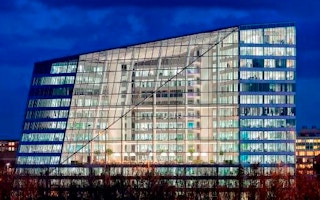Buildings account for as much as a third of global carbon emissions, according to the United Nations Environment Programme, and slashing their contribution would make a dent in global warming. This year saw the green building movement gain substantial momentum, particularly in emerging economies.
We take a look at the year’s biggest green buildings stories.
1. First ever ‘Buildings Day’ held
To support global efforts to reduce greenhouse gas emissions, more than a hundred business groups from the global construction and buildings sector unveiled ambitious plans in December to expand the green building movement around the world and certify about 1.25 billion square metres of space, an area nearly twice the land mass of Singapore.
Industry leaders and members of national green building councils made the announcement on the first ever Buildings Day at the United Nations climate summit known as COP21 in Paris, and pledged to speed up green initiatives in the industry over the next five years.
These initiatives include “net zero carbon” for new buildings - buildings that do not emit carbon dioxide -, energy efficiency projects and retrofitting existing buildings by 2050, the group said on its COP21 campaign website Better Build Green. The group - led by the World Green Building Council (WGBC) - comprises 24 national green building councils worldwide, including several in Asia Pacific such as India, Hong Kong, Singapore and Australia.
2. Green building demand doubles every three years
According to the World Green Building Trends 2016 report in November by Dodge Data & Analytics, green building space continues to double every three years, with strongest acceleration in emerging economies, and clients and tenants worldwide increasingly demanding sustainability.
The report surveyed more than 1,000 architects, engineers, contractors, owners, specialists and consultants in 69 countries to understand their current green building project involvement and expectations for 2018.
The findings, which will be fully available in early 2016, reaffirm previous research results in 2008 and 2012 that green building is doubling every three years on average.
Across all regions studied, respondents projected that more than 60 per cent of their projects would be green by 2018, with a doubling from current projects across the Middle East, North Africa, Asia, South America and Sub-Saharan Africa.
3. China overtakes the United States as country with the most green building space
China’s green building industry is expanding rapidly, with green space growing 154 times since 2008. This has resulted in the world’s largest economy overtaking the United States in terms of gross floor area, according to research from global real estate services company CBRE.
The New Era of Green Buildings in China found that as of January 2015, China had 2,538 projects with the country’s Green Building Evaluation Standard certification, representing gross floor area of 290 million square metres, as well as 627 Leadership in Energy & Environmental Design (LEED) projects as of April 2015, adding an additional 28 million sq m.
While China had begun relatively late in the green building space - with the first green building certified as recently as 2005 - the size of the Chinese construction industry, the largest in the world, means there is significant room for growth. With increasing concern over environmental issues and the Chinese government’s commitment to reform the economy, analysts expect much more will be done in the green building space.
4. The world’s most sustainable building opens in Amsterdam
Deloitte’s new corporate headquarters in Zuidas, Amsterdam, has been named the most sustainable office building in the world by UK’s Building Research Establishment Environmental Assessment Methodology (BREEAM). The building, called The Edge, took over the title from One Embankment Place in London, after being awarded an “Outstanding” rating with the highest ever BREEAM score of 98.36 per cent.
The 40,000 square meters building is 15 stories high, houses 1,800 people and is energy neutral, thanks to a combination of technologies: natural insulation and lighting, energy-efficient design, solar panels. Rainwater is collected for use flushing the building’s toilets and watering its green areas.
5. Green Mark celebrates 10 years
Singapore’s Building and Construction Authority (BCA) Green Mark Scheme was launched in January 2005 to drive Singapore’s construction industry towards more environment-friendly buildings. The scheme has helped Singapore green about 30 per cent of its built environment - from just 17 buildings in 2005 - making one of the greenest cities globally.
The first green building scheme to set standards for buildings in the tropics, the Green Mark programme now reaches more than 10 countries and over 280 projects across Southeast Asia.
In 2010, BCA became the first government agency outside North America to be conferred the prestigious Aspen Institute’s Energy and Environment Award. The award recognises BCA’s leadership in designing and implementing policies that promote clean energy technologies, or energy and environment conservation efforts.
In 2011, BCA became the inaugural winner of the World Green Building Council’s Regional Leadership Award. This is in recognition of BCA’s leadership to create a more sustainable built environment. BCA joined five other city authorities including San Francisco and New York to be highlighted by the World Green Building Council for leadership in government policy.
Earlier this year, the initiative celebrated its 10th anniversary and released a book that featured 50 best examples of green buildings in Singapore.
BCA also launched a new version of the scheme that promises to be a “game-changer” in raising sustainability standards of the building industry.
This story is part of our Year in Review series, which looks at the top stories that shaped the business and sustainability scene in each of our 11 categories.





















